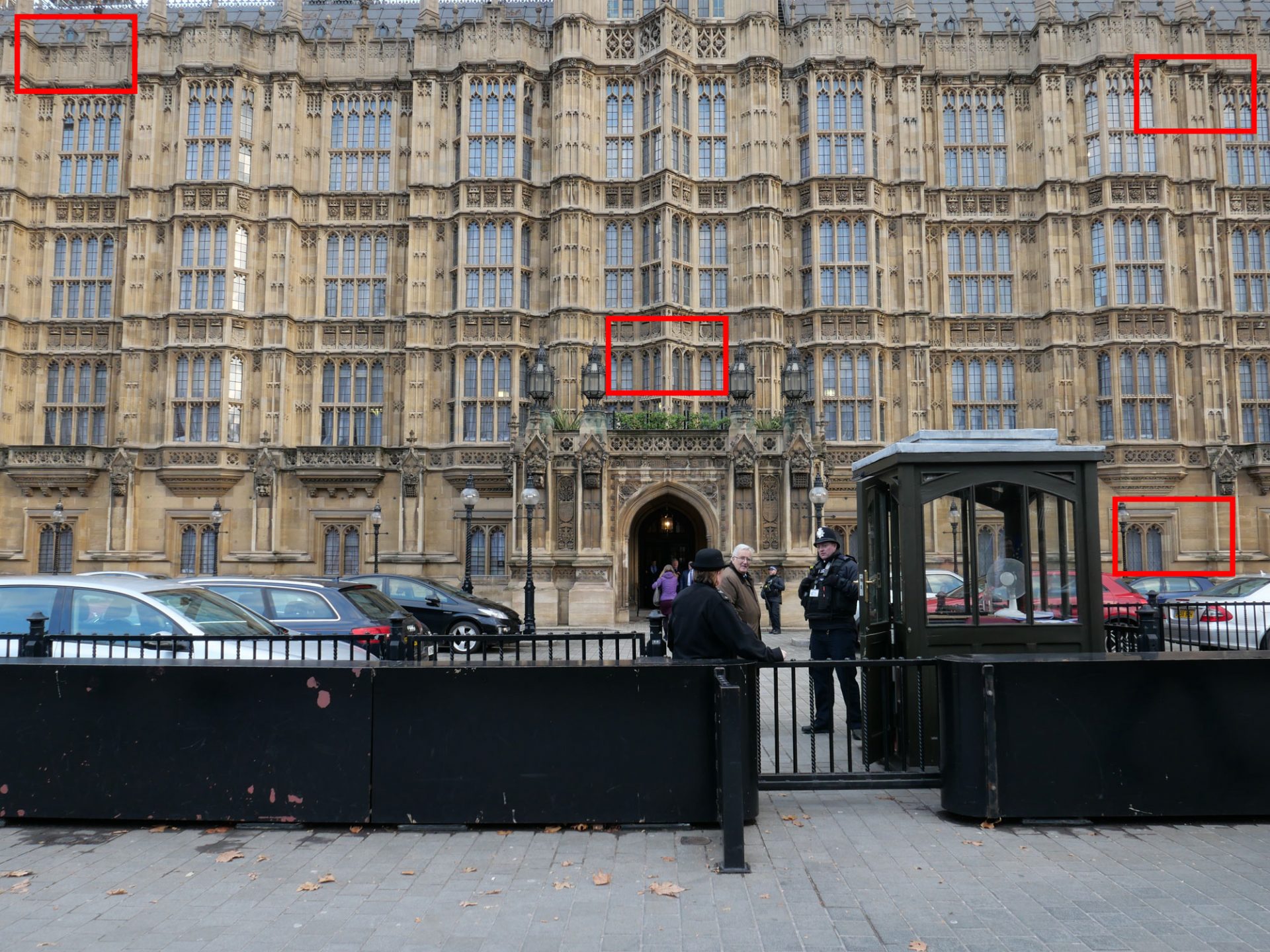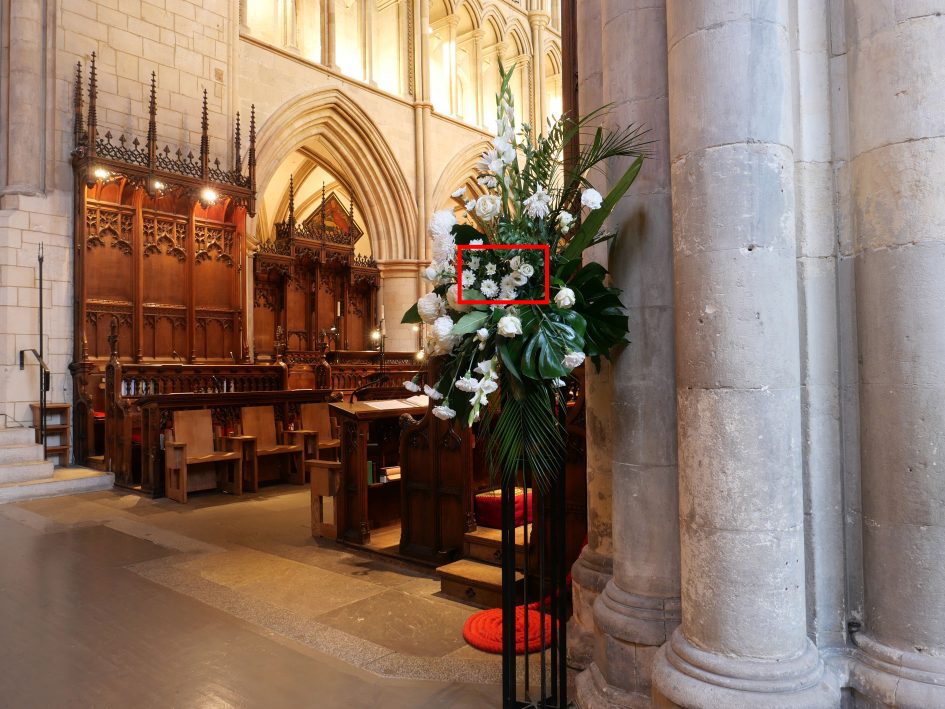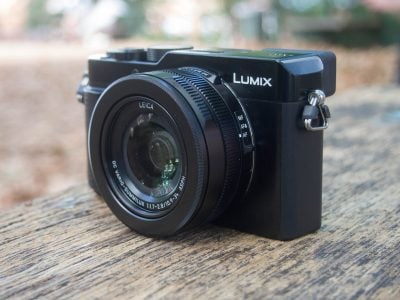Panasonic Lumix LX100 II review
-
-
Written by Ken McMahon
Quality
To test real-life performance, I shot this scene with the Panasonic Lumix LX100 II and the Canon PowerShot G1X III using their best quality JPEG settings and at their base sensitivity settings. Both cameras were mounted on a tripod, the lenses were set to their widest, 24mm equivalent focal length and image stabilisation was disabled. I set the aperture to f5.6 in Aperture priority mode, which I’d previously determined produced the best quality. At its base 200 ISO sensitivity setting the Lumix LX100 II metered an exposure of 1/40th of a second. At its 100 ISO base sensitivity setting, and also at f5.6, the PowerShot G1X Mark III selected 1/30th.

Just to recap on what we’re comparing here in terms of sensor size and resolution. The Lumix LX100 II is equipped with the same 20 Megapixel Four Thirds sensor employed by the Lumix GX9. But in order to keep the lens small and light, not all of the sensor is used and full sized images measure 4736 x 3552 pixels totalling approximately 17 Megapixels. If you haven’t already done so, take a look at the explanation at the bottom of the first page for more detail on how this works. By comparison, the PowerShot G1X Mark III has the same 24 Megapixel APSC sensor used in the EOS 80D DSLR or EOS M50 mirrorless camera – and it uses all of it. So, essentially, the G1X Mark III has the bigger sensor and delivers higher resolution images too.
Because of its larger higher resolution sensor the crops from the G1X Mark III on the right show a smaller area with larger detail than those from the Lumix LX100 II on the left. The Lumix LX100 II gets off to a poor start with the first crop from the top left corner of the frame, at least compared with the Powershot G1X Mark III’s crop which is sharper and suffers less from distortion.
It’s a different story in the second crop from the centre of the frame where, aside from the size difference, there’s very little to tell them apart. Both crops are sharp, with a good level of detail and no appreciable noise. Moving to the top right corner, once again there’s some distortion and softness in both crops. The difference is smaller, but I’d say the Canon G1X III is better on detail, though there’s is noticeable colour fringing on the Canon Crop. Moving down to the middle of the right hand edge of the frame, both final crops are an improvement on the corner, but here I’d say the Lumix crop is marginally better – there’s not much in it though.
Overall I think what you can take from this comparison is that if you’re concerned that the Lumix LX100’s smaller, lower resolution sensor might produce less detailed images, you needn’t worry. Broadly speaking, both sensors and lenses are comparable. Of course it’s worthing pointing out that APSC sensor’s superior dynamic range will enable the G1X Mark III to capture a greater tonal range and more saturated colours. It should also provide better noise performance at equivalent ISO sensitivities, but bear in mind that models like the Lumix LX100 II and Sony RX100 VA have brighter lenses, potentially allowing selection of lower sensitivities in equivalent lighting conditions. Scroll down to see how these two models compare for noise throughout their respective sensitivity ranges.

Above left: Panasonic Lumix LX100 II at 4.3mm (24mm equivalent) f5.6 200 ISO.
Above right: Canon PowerShot G1X III at 15mm (24mm equivalent) f5.6, 100 ISO.

Above left: Panasonic Lumix LX100 II at 4.3mm (24mm equivalent) f5.6 200 ISO.
Above right: Canon PowerShot G1X III at 15mm (24mm equivalent) f5.6, 100 ISO.

Above left: Panasonic Lumix LX100 II at 4.3mm (24mm equivalent) f5.6 200 ISO.
Above right: Canon PowerShot G1X III at 15mm (24mm equivalent) f5.6, 100 ISO.

Above left: Panasonic Lumix LX100 II at 4.3mm (24mm equivalent) f5.6 200 ISO.
Above right: Canon PowerShot G1X III at 15mm (24mm equivalent) f5.6, 100 ISO.
Panasonic Lumix LX100 II JPEG Noise

To examine noise levels under real-life conditions, I shot this scene with the Panasonic Lumix LX100 II and the Canon PowerShot G1X III at each of their ISO sensitivities using their best quality JPEG setting. Both cameras were mounted on a tripod and stabilisation was disabled.
I’d previously determined that both cameras produced best results at f5.6 so I set the Lumix LX100 II to Aperture priority mode and with the sensitivity at the base 200 ISO setting it metered an exposure of 4 seconds. In auto and semi auto exposure modes the PowerShot G1X III has a maximum 1 second shutter speed, so I set to it manual exposure to match the Lumix LX100 II’s exposure at each of the ISO settings. As usual the crops below are taken from the area marked in red above.
You’ll notice the PowerShot G1X III crops on the right show a smaller area with larger detail than those from the Lumix LX100 III on the left, see my outdoor test comparison above. That’s because the G1 X Mark III has a larger higher resolution sensor. For more details see my outdoor tests above. The other thing to note is that the Lumix LX100’s base sensitivity setting is 200 ISO compared with 100 ISO on the PowerShot GX1 Mark III. You need to turn on the extended ISO range on the LX100 III to unlock the 100 and 25600 ISO settings.
Looking at the crops, both models do an excellent job of keeping noise at bay right up to 1600 ISO. You can see noise textures in both 1600 ISO crops (and, if you look carefully, from 400 ISO up), but the image quality doesn’t suffer more than marginally due to their presence. In fact throughout the range there’s not a lot in it and, aside from the size difference, the two models look very similar not just in terms of the degree of noise, but its quality.
It would be interesting to see what’s going on behind the scenes here, are these two sensors really delivering a similar noise performance, or is it the processing that’s doing some of the work? To find out I shot the same scene with both cameras set to RAW capture, the RAW files in the second table were processed in Adobe Camera RAW using sharpening of 50 / 0.5 / 36 / 10, and with noise reduction disabled to really see what’s going on behind the scenes.
As with the JPEGs, the RAW files don’t reveal any striking difference between the two sensors, so it would appear that the advantage of the bigger higher resolution sensor in the PowerShot G1X is confined to delivering more pixels, and superior dynamic range with a lower 100 ISO base sensitivity.

Above left: Panasonic Lumix LX100 II, f5.6, 100 ISO. Above right: Canon PowerShot G1X III, f5.6, 100 ISO.

Above left: Panasonic Lumix LX100 II, f5.6, 200 ISO. Above right: Canon PowerShot G1X III, f5.6, 200 ISO.

Above left: Panasonic Lumix LX100 II, f5.6, 400 ISO. Above right: Canon PowerShot G1X III, f5.6, 400 ISO.

Above left: Panasonic Lumix LX100 II, f5.6, 800 ISO. Above right: Canon PowerShot G1X III, f5.6, 800 ISO.

Above left: Panasonic Lumix LX100 II, f5.6, 1600 ISO. Above right: Canon PowerShot G1X III, f5.6, 1600 ISO.

Above left: Panasonic Lumix LX100 II, f5.6, 3200 ISO. Above right: Canon PowerShot G1X III, f5.6, 3200 ISO.

Above left: Panasonic Lumix LX100 II, f5.6, 6400 ISO. Above right: Canon PowerShot G1X III, f5.6, 6400 ISO.

Above left: Panasonic Lumix LX100 II, f5.6, 12800 ISO. Above right: Canon PowerShot G1X III, f5.6, 12800 ISO.

Above left: Panasonic Lumix LX100 II, f5.6, 25600 ISO. Above right: Canon PowerShot G1X III, f5.6, 25600 ISO.
Panasonic Lumix LX100 II RAW Noise

Above left: Panasonic Lumix LX100 II, f5.6, 100 ISO. Above right: Canon PowerShot G1X III, f5.6, 100 ISO.

Above left: Panasonic Lumix LX100 II, f5.6, 200 ISO. Above right: Canon PowerShot G1X III, f5.6, 200 ISO.

Above left: Panasonic Lumix LX100 II, f5.6, 400 ISO. Above right: Canon PowerShot G1X III, f5.6, 400 ISO.

Above left: Panasonic Lumix LX100 II, f5.6, 800 ISO. Above right: Canon PowerShot G1X III, f5.6, 800 ISO.

Above left: Panasonic Lumix LX100 II, f5.6, 1600 ISO. Above right: Canon PowerShot G1X III, f5.6, 1600 ISO.

Above left: Panasonic Lumix LX100 II, f5.6, 3200 ISO. Above right: Canon PowerShot G1X III, f5.6, 3200 ISO.

Above left: Panasonic Lumix LX100 II, f5.6, 6400 ISO. Above right: Canon PowerShot G1X III, f5.6, 6400 ISO.

Above left: Panasonic Lumix LX100 II, f5.6, 12800 ISO. Above right: Canon PowerShot G1X III, f5.6, 12800 ISO.

Above left: Panasonic Lumix LX100 II, f5.6, 25600 ISO. Above right: Canon PowerShot G1X III, f5.6, 25600 ISO.
Check prices on the Panasonic Lumix LX100 II at Amazon, B&H, Adorama, or Wex. Alternatively get yourself a copy of my In Camera book or treat me to a coffee! Thanks!



